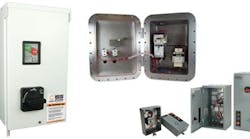That's what suppliers have been doing with motor starters, and the results are impressive.
Perhaps the greatest benefit to machine builders, robot builders and process skid builders — and their customers — is the combination of multiple components that make up a motor starter system in one unit. Machine builders no longer have to purchase, install and wire a disconnect switch, a contactor, an overload, start/stop pushbuttons, indicating lights, and interposing relays. Instead, they can purchase one unit that combines all or most of these functions.
"Increased use of Type E devices that include motor disconnecting means, branch short circuit and ground fault protection, motor control and reliable overload with phase loss protection, all in one compact device, reduces total cost," says Peter Damesimo, manager for engineering and quality at c3controls.
"Our starters incorporate the motor protective circuit breaker, line-side terminal barrier, trip-indicating auxiliary contacts and contactor, which simplifies bills of material and reduces inventory requirements," Damesimo adds. "Enhanced efficiency and cost reduction is achieved through an integrated modular design that enables a pre-wired enclosed motor starter to be ordered as a single part number, making it easy to just connect and go."
For machine builders and end users that need expanded built-in control capability, motor starters incorporating this functionality are available. Cerus Industrial has a starter that comes in a standard version with start/stop pushbuttons, and with five status LED pilot lights. Also included are two wet contacts for 12–250 Vac/dc input start/stop commands, four normally open dry contact inputs for external pilot devices or start/stop commands, and status output contacts — eliminating the need for interposing relays in many cases.
"The starter will work with any three-phase voltage from 208–600 V up to 40 A, and that makes it ideal for complex systems or facilities that might have more than one voltage available," comments Dylan Hively, industrial division manager at Cerus.
If a builder or end user is using an automation system that can communicate over the IO-Link protocol, then Siemens Industry has a motor starter solution that can save wiring costs from the controller to the motor starters, as well as provide additional diagnostic information that can help reduce downtime.
"IO-Link is a 24 Vdc system with connections via a standard three-conductor sensor cable to the first of four starters in a group installation," points out Brian Libby, product manager with Siemens. "Connection to the other three starters is accomplished via a plug-in ribbon cable, and up to four groups of four starters can be connected, for a total of 16 starters. Individual starter data is then communicated via the three-conductor cable back to an IO-Link master module. Data such as main contact position, individual tripped, overload, short circuit, motor direction and end-of-life indication are all communicated back to the controller."
Panel space is at a premium for many machine builders and their customers, and suppliers are responding with increasingly compact designs. "At only 22.5 mm wide, our Contactron motor starter occupies half the DIN-rail space of a typical IEC non-reversing motor starter, and one-quarter the space of a reversing starter," notes Mark Buckley, lead product marketing specialist for Contactron at Phoenix Contact.
Finally, OEMs want to use components that don't have to be replaced due to wear and tear, since it's typically not easy to service machines and systems that have been shipped halfway around the world. "A typical IEC-style starter has a life expectancy of 3 million switching cycles," Buckley states. "Our hybrid motor starters and contactors have a life expectancy of 30 million switching cycles. That means, for example, if a machine needs to replace its starters once a year, the operators can reduce that scheduled maintenance to once per decade."





